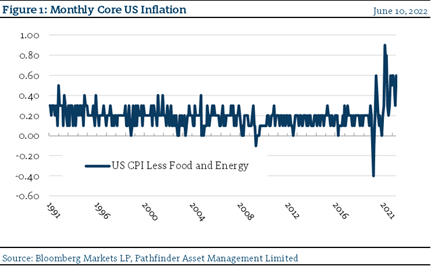Rate Increases and Market Expectations
Last week, we wrote about the US Consumer Price Index topping a 40-year high and coming in at 8.6% for the year. The real impact from the data was that broad prices (excluding the food & energy components) had increased month over month, indicating that general inflation was rising. Food and Energy comprise just over 21.5% of the index and they can skew the results higher or lower quite dramatically. The issue last week was that month-on-month change in broad inflation had increased. Expectations, on the other hand, were that the index would be flat or even decrease. This caused concern that the US Federal Open Market Committee (FOMC) would increase administered rates higher than what was expected and that potentially inflation was getting out of control.
- We reprint Figure 1 again this week to present the increase in broad inflation that has obviously accelerated since the beginning of the year. One item to note was that this data was released just 5 days ahead of the FOMC meeting, which took place on Tuesday of this week.
- Prior to the data being released, “the market” was expecting a 50-basis point raise from its current level of 1.0%. The market also expected that the administered rate would peak in the spring of 2023 at 3.0%. Just ahead of the meeting, markets were still expecting a 50-basis point increase, but the peak rate had increased to just under 4.0%. The FOMC did in fact raise interest rates more than expected, moving an aggressive 75-basis points higher. It was also indicated that they could do so again at the next meeting in July. The FOMC Chair also noted that this was the first time in his career that data received so close to the meeting had impacted the ultimate decision. At first, this was viewed favourably resulting in a strong close for North American equities, but markets subsequently reversed the next day reinforcing a new official “bear” (top to bottom drop of 20%) in most global markets.

“This means that”, as we wrote last week, we should expect more volatility from financial markets as both central banks and investors work through higher inflation expectations. Interestingly, the Bank of England took a more dovish approach with their rates and Japan was even more accommodative, basically refusing to raise their rates from -0.1%. China, on the other hand, is dealing with completely different issues given that they have very little inflation and an economy that is suffering from COVID mitigation measures. This diversity of approach and situation in various parts of the world is one element of the investment landscape that has changed dramatically. It will create new risks, but also provide new opportunities.
National Instrument 31-103 requires registered firms to disclose information that a reasonable investor would expect to know, including any material conflicts with the firm or its representatives. Doug Johnson and/or Pathfinder Asset Management Limited are an insider of companies periodically mentioned in this report. Please visit www.paml.ca for full disclosures.
*All returns are time weighted and net of investment management fees. Returns from the Pathfinder Partners’ Fund and Partners’ Real Return Plus Fund are presented based on the masters series of each fund. The Pathfinder Core: Equity Portfolio and The Pathfinder Core: High Income Portfolio are live accounts. These are actual accounts owned by the Pathfinder Chairman (Equity) and client (High Income) which contain no legacy positions, cash flows or other Pathfinder investment mandates or products. Monthly inception dates for each fund and portfolio are as follows: Pathfinder Core: Equity Portfolio (January 2011), Pathfinder Core: High Income Portfolio (October 2012) Partners’ Fund (April 2011), Partners’ Real Return Plus Fund (April, 2013), and Partners’ Core Plus Fund (November 2014).
Pathfinder Asset Management Limited (PAML) and its affiliates may collectively beneficially own in excess of 10% of one or more classes of the issued and outstanding equity securities mentioned in this newsletter. This publication is intended only to convey information. It is not to be construed as an investment guide or as an offer or solicitation of an offer to buy or sell any of the securities mentioned in it. The author has taken all usual and reasonable precautions to determine that the information contained in this publication has been obtained from sources believed to be reliable and that the procedures used to summarize and analyze such information are based on approved practices and principles in the investment industry. However, the market forces underlying investment value are subject to sudden and dramatic changes and data availability varies from one moment to the next. Consequently, neither the author nor PAML can make any warranty as to the accuracy or completeness of information, analysis or views contained in this publication or their usefulness or suitability in any particular circumstance. You should not undertake any investment or portfolio assessment or other transaction on the basis of this publication, but should first consult your portfolio manager, who can assess all relevant particulars of any proposed investment or transaction. PAML and the author accept no liability of any kind whatsoever or any damages or losses incurred by you as a result of reliance upon or use of this publication.